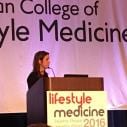Written by Marsha Seidelman, M.D.
October 29, 2016
Lifestyle medicine – just the name conjures up thoughts of docs lying on a beach, drink in hand, stethoscope dangling just above the sand, doesn’t it? I just returned from a conference hosted by the American College of Lifestyle Medicine with four other doctors from our group. Even the T-shirt for the event has palm trees with a light and breezy effect, suggesting that lifestyle medicine has something to do with relaxation.
Well, that’s not what Lifestyle Medicine is about, even though that can help get you in the proper state of mind for approaching it. The idea behind lifestyle medicine is to live your life with the goal of long term good health – or longevity and vitality, as the speakers asserted. Live in a way to promote good health rather than to passively wait for illness to arise.
We would all like to enjoy good health and recuperate quickly from illnesses that come our way. That ‘good fortune’ doesn’t happen by chance. Genes and circumstances matter. But the way we eat and drink, sleep and exercise, and interact with others, can all contribute to a happier, healthier life — now and in the future. You can say, “I’d like to be healthy and mobile in 10, 20, 30 years,” but if you’re not actively engaged in that goal, you’re less likely to achieve it.
In the U.S., life expectancy has increased, but people are often suffering from chronic illnesses during their extended life span. Preventable chronic conditions take up 80% of healthcare dollars. Lifestyle medicine physicians do treat with medication when needed. However, fewer meds are necessary if lifestyle factors are optimized. Our population and our health care costs are suffering due to our current habits that result in overweight/obesity, high blood pressure, high cholesterol, diabetes, strokes and heart disease and cancer. Not all are preventable, but many are.
A major focus of the conference was the adoption of whole food, plant-based nutrition, for the benefit of the individual and our planet. This refers to a diet made up primarily of fruits and vegetables, lentils, beans, nuts, seeds, whole grains and soy products.
On the other hand, the Standard American Diet, or SAD, high in calories, saturated fat, sugar and salt, is a significant contributing factor to the chronic diseases noted above. In addition, consuming these processed foods can affect sleep, immune function, mood and mental clarity. When people complain about fatigue, for example, it isn’t clear to them that their symptoms may be related to their poor diet. Truly, you are what you eat. Eating whole foods and avoiding processed ones, will lower sugar, cholesterol and weight in those most at risk for heart disease. There is evidence that a plant-based diet can not only prevent disease, but can reverse heart disease and some autoimmune diseases when strictly adhered to. One of the pioneers of this concept was Dr. Dean Ornish, who documented a decrease in coronary artery plaques related to a healthy diet. He was honored with a Lifetime Achievement Award at this week’s conference. At the presentation, he participated in a very personal interview, capped off by his singing and playing guitar and being surprised by his loving wife – one of the highlights of the week.
In addition to being heart-healthy, high fruit and vegetable intake may lower breast cancer, whereas dairy products increase prostate cancer, meat can increase colon cancer, and SAD can increase gastric cancer. Fiber seems to be the common thread for the health benefits, and there is no fiber in animal products – meat, poultry, fish, dairy – none.
One of the major questions people ask about a plant-based diet is, “How do you get enough protein?” It turns out that most Americans consume way more protein than they actually need. Excess protein is stored as fat or sugar, just as any other excess calories are. The exact amount we need is controversial, but can be estimated at 0.3-0.5 grams per pound per day. A 150 pound person, then, should have approximately 45 -75 grams of protein per day. This can easily be obtained on a vegetarian diet from a variety of beans, nuts, seeds, soy, whole grains and vegetables. Yes, even vegetables supply some protein. Surprisingly peas have 6 grams of protein per cup.
Familiar foods that would give you 60 grams of protein in a day might include: oatmeal with berries, walnuts and soy milk for breakfast; split pea soup, whole grain bread with hummus and a salad for lunch; apple and peanut butter for a snack; and black beans and brown rice tortillas with avocado and salsa for dinner. You might worry about supporting an active lifestyle on a vegetarian diet, but it turns out that many marathoners are plant-based and feel that they are faster and feel better by avoiding meat. If needed, calories can be increased by adding more nuts, whole grains, and avocado or by increasing the use of healthy oils.
When we look at American youth and the high rate of obesity, only 7% score intermediate or better on the ‘healthy diet’ score of the American Heart Association. Part of this problem has been brought on by the food industry. They have spent their research dollars to determine the optimal combination of salt, sugar and fat that keeps consumers asking for more – creating a true food addiction. And then spend some more to advertise it to youth and to all other consumers. If you want to get angry at how the public has been drawn into this processed food addiction, take a look at Michael Moss’ Salt Sugar Fat, How the Food Giants Hooked Us, or David Kessler, M.D.’s The End of Overeating, Taking Control of the Insatiable American Appetite.
It’s clear from scientific research that a plant-based diet is better for the individual. Several of the speakers drove home the idea that it’s better for planet earth as well. The land and water needed to raise grain to feed the cattle – instead of raising crops to feed people directly – wastes 96% of the grain’s calories and 100% of the fiber. For every ‘quarter pounder’, the grain used to produce that small amount of meat could have fed 3 people for an entire day. In a world with 7 billion people and a finite food supply, ‘hogging’ the resources for meat production leaves a significant part of the world population without affordable, healthy food. Fast forward to 2050 with another billion or two people on earth, and there won’t be enough land or water to support a meat-eating population.
Each time I attend a wellness conference, I’m more and more convinced that a predominantly or fully plant-based diet is crucial for personal and global reasons. If you’d like help getting started with vegetarian recipes or explore reasons to eat a plant based diet, try the sites listed below. Your inner self will thank you for it.
https://resources.plantricianproject.org/default/batches/plantricianresources – articles about protein, calcium, and health research
http://www.vegkitchen.com/nutrition/protein/ – protein for plant-based diets – info and recipes
www.lighter.world – get recipe suggestions to start planning a plant based diet.
http://cookieandkate.com/category/food-recipes/entrees/ – a recipe site for vegetarian recipesor try some of our recipes on Lady Docs, most of which are plant-based
Happy eating!!
Tags: lifestyle medicine, whole foods plant based diet









Tags:
